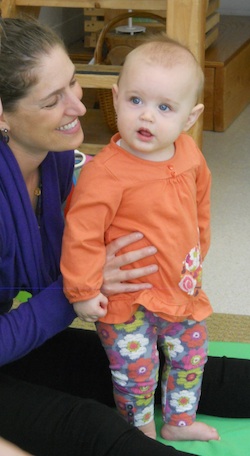By Janis Siegel, JTNews Correspondent
The 20 or so moms and dads who came to the final lecture of the parenting series at the Stroum Jewish Community Center “kvelled” when asked about their children.
“They are sensitive,” said one parent. They are kind, loving, curious, helpful, tender, extremely active, great big brothers, courageous, cheerful, strong-willed, firecrackers, silly, athletic, and loving, said the rest, smiling from ear to ear.
But when those same loving bundles of joy don’t want to leave the park, tie their shoes, or put down a toy, things can change very quickly, said Emily Shapiro, education coordinator for the Infants, Ones and Twos program at the SJCC’s early childhood school.
That’s when modeling, one of the techniques parents came to learn from the “Fostering Empathy in Young Children” talk, can transform chaos into communication, and help kids identify their feelings first.
“I need to put my frustrations aside and help them come back before I deal with my emotions,” Shapiro told the intimate, end-of-the-school-year group made up of parents of varying ages who were trying to glean as many coping skills as they could.
“When a child is falling apart, or a child is pushing another child, we like to think that there’s a reason your child is doing that,” Shapiro said. “It’s important for us to help them identify what they’re doing and why they’re doing it.”
In these high-stress moments, she said, parents can actually help children build “an emotional vocabulary.”
“Maybe your child knocked down the vase and you’re really feeling angry with them,” Shapiro said. “Put that aside for a moment and help them get through this difficult situation. Then deal with [your] frustration.”
The SJCC school is one of only two pilot programs in the U.S. that uses a curriculum called the Roots of Empathy program, developed by Canadian educator Mary Gordon.
At its core, Roots of Empathy incorporates classroom visits from a parent and an infant. Using “guided observations,” facilitators helps children become familiar with loving behavior while they also learn to understand their own reactions, thoughts, and feelings.
“Empathy is a huge part of this school,” Dana Weiner, the SJCC’s senior director of family education and outreach told JTNews. “The whole goal is to support families and their parenting, help them bond with their kids, and understand child development.”
One technique, “Emotions Through a Lens,” asks students to use colors, a plant, or other objects to imagine life from its perspective and talk about it. Educators at the ECS say they also use storytelling, where an adult develops a scenario, either from family, friends or fantasy characters that kids can relate to and empathize with.
“We give them some tools to embrace when kids have strong feelings,” Weiner said. “These kids are pretty sophisticated in terms of understanding what they’re feeling and articulating them.”
Another strategy used in the school includes developing what social neuroscience researchers call “mirror neurons” in children. Triggered by the hormone oxytosin, the researchers say these hormones can help children learn to deeply intuit another’s feelings. Then, parents and teachers can ask the leading questions.
“Why is someone crying?” asked Shannon Cruzen, presenter and pedagogical coordinator for the early childhood school. “A child can develop empathy just watching a baby, or the attachment between a mother and a baby.”
Cruzen advises parents to help their child identify and encourage him to explain his feelings. After a child opens up and expresses himself, a hug lets the child know he can always go to an adult to find help and feel better, she added.
Other lectures in the center’s year-long parenting series sold out to capacity crowds. In February, a showing of the documentary Race to Nowhere, had 270 parents sign up and its ParentMap and Raising Boys workshops each drew 350.
The educators agreed that learning to recognize and respect the feelings of others has benefits far beyond childhood and the classroom. Interpersonal emotional skills can give students an edge in society when they graduate and enter the working world.
“What we know is that when children leave our school, and school, in general, is that they need to go out into the workforce and maintain and nurture relationships,” Shapiro said. “We think that fostering empathy in young children is just as important as helping children achieve academic success. They need to be able to think about other people to be successful.”
